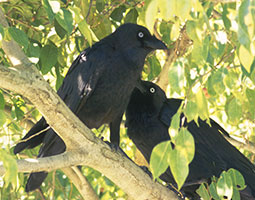Corvus orru
Description

The Torresian Crow is a very large crow with glossy black feathers with a purple sheen, a short throat hackle (feathers) and a white under-down. They have a black beak and legs, and distinctive white eyes that are outlined by a fine blue ring. Younger crows tend to not be as glossy and have brown eyes rather than white. When this species of crow lands, they tend to shuffle their wings and do an unusual hop/walk as they prepare to take flight. Torresian Crows will often form large flocks when they are outside their breeding season. They are highly opportunistic feeders and will feed mostly on the ground.
These birds breed from August to February when they form a monogamous breeding pair that protects a fixed territory. The nest, which is a simple cup-shaped nest of sticks, is built by both the male and the female in a Eucalyptus tree or man-made structures like power poles or windmills in farmland that are over 10m tall. During the breeding season they will lay 4 – 5 spotted eggs that have a tinge of blue. Both the male and female take up the feeding of the chicks when they hatch, and the young typically leave the nest (fledge) after 5 - 7 weeks. The fledglings will then stay with their parents for three months before gaining independence.
Torresian Crows are very common and prefer to live on the fringes of rainforests, open woodlands and forests and also along beaches. In particular it likes to inhabit the dry areas around watercourses especially if they have tall trees which it needs for nesting. They have become very well adapted to living in urban areas where they can become reliant on artificial food sources, as a result this combined with their raucous noisy call can make them become a nuisance. They can also be a pest on farmland where they will raid a wide variety of crops for food.
This species of crow is distributed across the northern states of Australia from Geraldton in Western Australia to Forster in New South Wales. Although it is most common along the tropical coast, it can also be found inland in patches. It is also found inhabiting some of the island countries to the north of Australia.
Adaptations
- Generalist feeders and can alter diet depending on food availability
- May swoop to protect their nest
- Known to teach advantageous behaviours to others in their flock (culture)
- Intelligent and adaptable (have been known to steal food from larger birds by working in teams and can eat the poisonous cane toad by avoiding the poisonous parts of the toad).
- Live in a broad range of habitats
Feeding relationships
- What I eat: mostly grain but also eats fruit, insects and other invertebrates, eggs, garbage and carrion (dead animals)
- What eats me: carpet pythons, cats, dogs and foxes
Interesting facts
There are six different species of crow that live in Australia: five native breeding species and one that occasionally forms populations through self-introduction. Most of these species are very similar in appearance, and can be difficult to tell apart. Luckily, they are mostly well separated in terms of their geographic range which helps identification.